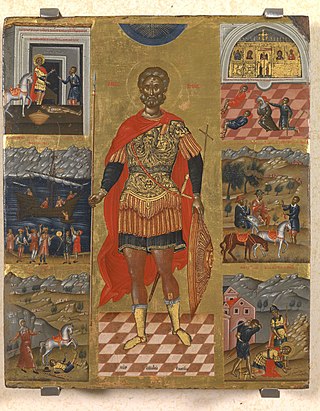
Cretan School describes an important school of icon painting, under the umbrella of post-Byzantine art, which flourished while Crete was under Venetian rule during the Late Middle Ages, reaching its climax after the Fall of Constantinople, becoming the central force in Greek painting during the 15th, 16th and 17th centuries. The Cretan artists developed a particular style of painting under the influence of both Eastern and Western artistic traditions and movements; the most famous product of the school, El Greco, was the most successful of the many artists who tried to build a career in Western Europe, and also the one who left the Byzantine style farthest behind him in his later career.

The Heptanese School of painting succeeded the Cretan School as the leading school of Greek post-Byzantine painting after Crete fell to the Ottomans in 1669. Like the Cretan school, it combined Byzantine traditions with an increasing Western European artistic influence and also saw the first significant depiction of secular subjects. The school was based in the Ionian Islands, which were not part of Ottoman Greece, from the middle of the 17th century until the middle of the 19th century. The center of Greek art migrated urgently to the Ionian islands but countless Greek artists were influenced by the school including the ones living throughout the Greek communities in the Ottoman Empire and elsewhere in the world.
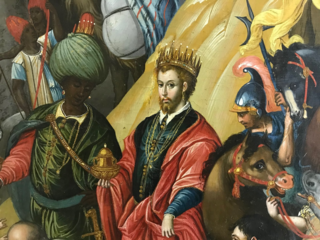
Michael Damaskenos or Michail Damaskenos was a leading post-Byzantine Cretan painter. He is a major representative of the Cretan School of painting that flourished in the 16th and 17th centuries. Painters Georgios Klontzas and Damaskenos were major contributors to the Cretan School during the same period. Damaskinos traveled all over the Venetian Empire painting. He remained loyal to his Greek roots stylistically but incorporated some Italian elements in his work. He was strongly influenced by the Venetian school. He painted parts of the Cathedral of San Giorgio dei Greci. Damaskenos has 100 known works. He influenced the works of Theodore Poulakis.

Theodore Poulakis was a Greek Renaissance painter and teacher. He is considered the father of the Heptanese School and one of the most prolific painters of Venetian Crete. Poulakis was a member of the Cretan School, his contemporary was Emmanuel Tzanes. Emmanuel Tzanes and Poulakis were active painters of the Cretan School until Candia, went to war with the Ottomans around 1649. Candia finally fell after twenty years of siege in 1669. Poulakis settled on the island of Corfu. Stephanos Tzangarolas was another famous painter in Corfu around the same period. Poulakis's works are likened to Andreas Pavias and Georgios Klontzas. Poulakis works exhibit qualities of the Venetian school. Over 130 of his paintings have survived and can be found all over the world.

Philotheos Skoufos Greek: Φιλόθεος Σκούφος also known as Filotheos Skoufos. Philotheos was a Greek painter, educator and clergyman during the 17th century. He collaborated with Emmanuel Tzanes on several pieces while he was in Corfu. Philotheos was a member of the Cretan School and Heptanese School. His work was influenced by the Venetian school. He was briefly affiliated with the famous Greek church in Venice San Giorgio dei Greci. Emmanuel Tzanes and Konstantinos Tzanes were also in Venice around the same period and affiliated with San Giorgio dei Greci. He was the priest who presided over famous painter Ioannis Moskos's wedding. Philotheos was active on the Ionian Island while Theodore Poulakis and Elias Moskos also had active workshops. Skoufos most popular works were the Stoning of St Stephen and the Virgin in the Temple.

Frantzeskos or Franghias Kavertzas was a Greek painter. His painting style resembles the late Cretan School or early Greek Baroque period. His work was influenced by Georgios Klontzas, Michael Damaskinos and Emmanuel Tzanfournaris. He was active in Crete during the early part of the 17th century roughly after the death of Georgios Klontzas. He painted two icons that are very similar to Klontzas's most notable pieces. Theodore Poulakis also painted similar themes. Kavertzas artwork incorporates the Venetian school. His works influenced Leos Moskos. His most notable works are the Last Judgement, In You Rejoiceth.

Ιoannis Apakas, also known as Johann Apakass was a Greek painter and priest. He was active in the latter part of the 16th century to the early 17th century. He was popular artist during his time.

Georgios Kastrofylakas (Greek: Γεώργιος Καστροφύλακας, 1699/1705 – 1760/1770), also known as Georgios Kastrofylax or (Zorzis). He is one of the few Greek painters that remained in Crete. Others included Ioannis Kornaros. Kornaros was his student. Kastrofylakas followed the lines of the Cretan School. His work was influenced by legendary artists such as Georgios Klontzas, Michael Damaskinos and Angelos. Historians argue Kastrofylakas had many students due to the resemblance of his work. He belongs to the Neo-Hellenikos Diafotismos in painting and the Greek Rococo period. He influenced countless Greek iconographers. Thirty-six paintings are attributed to Kastrofylakas. The artist added more realism to his paintings. Most of his artwork is in Heraklion, Crete. His most notable work is the Adoration of the Magi.
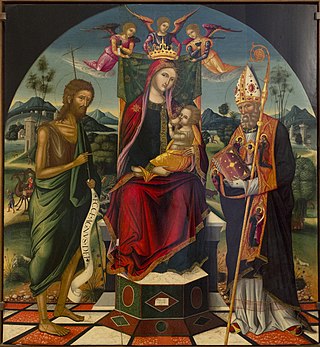
Madonna and Child enthroned with St. John the Baptist and St. Augustine is an oil painting by Greek painter Ioannis Permeniates. He was from Crete living in Venice. He was active during the first part of the 16th century. There are dozens of works attributed to the artist. He is a cross-over artist who painted in both the maniera greca and the Venetian style. Other similar artists were El Greco and Michael Damaskinos. Ioannis Permeniates's work was influenced by Vittore Carpaccio and Giovanni Bellini. His most notable painting is the Madonna and Child enthroned with St. John the Baptist and St. Augustine. Many Italian artists painted the same subject matter. The most famous painting depicting the subjects is the Madonna and Child with St John the Baptist and St Augustine by Petrus Perusinus. The Permeniates is part of the collection Museo Correr in Venice, Italy.
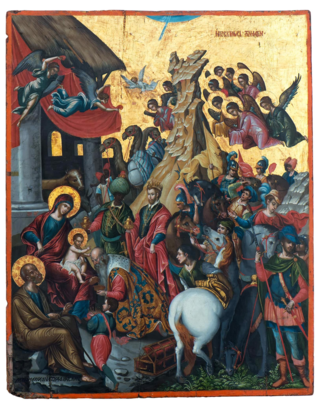
Adoration of the Kings also known as the Adoration of the Magi is a popular tempera painting by Greek painter Michele Damaschino. The painting is roughly the same size as Damaschino's The Last Supper. Both paintings were created around the same period. Michele Damaschino painted in parts of Italy and Greece. He was primarily active in Heraklion, Sicily, and Venice. He is a major representative of the Cretan Renaissance. He was a Cretan Renaissance painter who painted in the Greek mannerisms prevalent at the time. He also blended the style with the Venetian technique creating a new prototype of painting. He was followed by countless artists both Greek and Italian. His version of the Adoration of the Kings is a very important painting because it reveals the mixture of painting styles prevalent in most of his works. The Adoration of the Kings is now in the Monastery of Agia Aikaterini in Heraklion, Crete. It is part of the collection of Saint Catherine's Monastery Mount Sinai, Egypt.

The Stoning of Saint Stephen is an egg tempera and gold leaf painting created by Greek master Michael Damaskinos. He was a member of the Cretan school. He integrated Venetian painting with the Greek mannerisms prevalent at the time. Damaskinos was active in Heraklion, Sicily, Venice, and other parts of Italy. The Stoning of Stephen has been depicted by countless Greek and Italian painters. Saint Stephen was a protomartyr. He was the first martyr of Christianity. He was stoned to death for following the new faith. The painting is a depiction of that event.

The Virgin of the Burning Bush was a painting made of egg tempera and gold leaf on a wood panel. The portable icon was signed by Greek painter Michael Damaskinos. Damaskinos has over 100 known works. He was a distinguished member of the Cretan school of painting. He was from Crete. His contemporaries included Georgios Klontzas and El Greco. Damaskinos spent over twenty years traveling all over Italy. He spent a significant time in Venice. He adopted Italian artistic mannerisms which he applied to his paintings.

The Stoning of Stephen is a tempera and gold leaf painting by Philotheos Skoufos. Skoufos was active on the island of Crete. He traveled to Venice and eventually settled on the island Zakynthos. He was briefly a priest at the famous Greek church in Venice San Giorgio dei Greci. Nineteen of his works have survived. Skoufos created notable copies of Damaskinos's paintings namely The Stoning of Stephen and The Beheading of John the Baptist.

Lady the Lambovitissa is a tempera painting by Emmanuel Tzanes. Tzanes was a Greek painter active from 1625 to 1690. His artistic periods can be broken into three parts. The Cretan Period (1625-1647), The Corfu Period (1647-1655), and the Venetian Period (1655-1690). He was a prominent member of the Late Cretan School. His art was heavily influenced by Greek painter Michael Damaskinos. His brothers Marinos Tzanes and Konstantinos Tzanes were both painters. Tzanes has a massive art collection attributed to him nearing over one hundred thirty works. During the Corfu Period (1647-1655), Konstantinos Tzanes and Emmanuel were heavily active. They painted many works on the island.
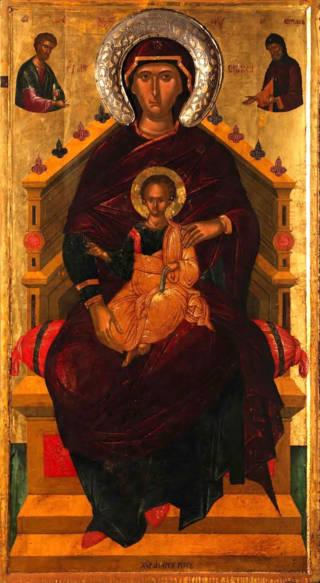
The Virgin Pantanassa is a tempera painting by Andreas Ritzos. Ritzos was a Greek painter active on the island of Crete. He flourished from 1435 to 1492. The painter has an existing catalog of over sixty works attributed to him. He signed his works in both Greek and Latin. He is one of the most influential painters of the Cretan Renaissance. He painted in the traditional Greek-Italian Byzantine style. His work was also heavily influenced by Venetian painting. His teacher was Angelos Akotantos. He was also affiliated with Andreas Pavias. His son was famous Greek painter Nikolaos Ritzos. Ritzo's Italian contemporaries were Paolo Uccello and Fra Angelico. They all painted a mixture of the Greek-Italian Byzantine and Italian Renaissance styles. The art of Crete was heavily influenced by the founder of the Venetian school Paolo Veneziano.

The Virgin Glykofilousa with the Akathist Hymn is a tempera painting created by Greek painter Stephano Tzangarola. The work is a symbol of the craftsmanship of the Heptanese School and the evolution of Greek painting from the Byzantine style to the Cretan Renaissance style. Tzangarola was originally from Crete and migrated to Corfu. The Ionian Islands became the artistic center of the Greek world. He was active from 1675 to 1710 during the Greek Baroque period and Rococo. Twenty-two of his works survived. His student was famous Greek painter and Archpriest Andreas Karantinos.
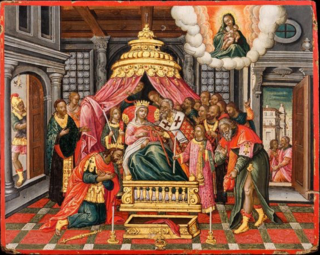
The Miracle of the Holy Belt was completed by Theodore Poulakis. He was a Greek painter originally from the village of Chania, Crete. He was associated with the Cretan School. He eventually migrated to the Ionian Islands. He was a member of the Heptanese School. He settled on the island of Corfu. He was a famous teacher. He signed a six-year contract to teach painting to Marinos Damistras son Tzorzi. The contract stipulated that his student had to follow him to Venice. Poulakis frequently traveled all over the Venetian Empire. During one period of his life, he stayed in Venice for over 13 years. He was very active within the painting community. He was also involved with the prestigious quarantia council. One hundred thirty of his work survived.
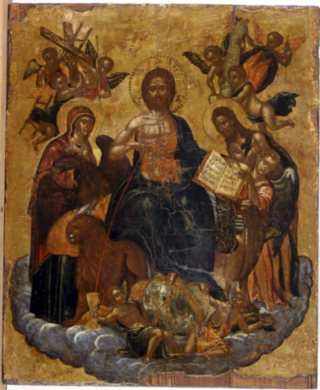
Tribute to the Eucharist was a painting made of egg tempera and gold leaf on a wood panel. The portable icon is attributed to Greek painter Michael Damaskinos. Damaskino's existing catalog features over 100 known works. He was a member of the Cretan school of painting. He was from the island of Crete. His contemporaries were Georgios Klontzas and El Greco. Damaskinos traveled all over Italy for over twenty years. He spent a significant amount of time in Venice. He adopted Italian mannerisms. He applied these new attributes to his paintings. He was friends with sculptor Alessandro Vittoria. He had a collection of drawings obtained from other Italian artists. Namely the Mannerist Parmigianino. He was also exposed to the magnificent works of Italian painter Raphael.

The Incredulity of Saint Thomas is a tempera painting created by Greek painter Emmanuel Tzanes. Tzanes features a catalog of artwork numbering over one hundred works. He was one of the most prolific artists of the 1600s painting in Crete, Corfu, and Venice. His two brothers Marinos Tzanes and Konstantinos Tzanes were also famous painters but Marinos is more well known for his famous poem The Cretan War Ο Κρητικός Πόλεμος. All three artists were members of the Late Cretan School and early Heptanese School (painting) they were known for participating in the movement that integrated Flemish engravings into the Greek and Italian art world.

Transfiguration and Monastic Scenes is a multi-themed tempera painting created by Greek painter Georgios Klontzas. Klontzas was a Cretan Renaissance painter. The artist was hired to assess work completed by El Greco. Klontzas was from a wealthy family and owned a successful workshop in the center of Crete. His existing catalog consists of Fifty-four works. He completed incredible triptychs and manuscripts. Klontzas and Micheal Damaskinos are two of the most prominent Greek painters of the 16th century due to the size of their catalogs and the popularity of their works excluding El Greco.





















